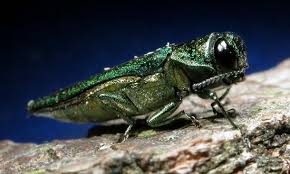The emerald ash borer has changed Bud Clark’s tree care company as much as it has the landscapes of the communities where he works.
Serving the wooded upscale suburbs north of Chicago, Canopy Tree Specialists’ traditional focus has been on the trimming and preservation of trees. It’s the type of work Clark, a certified arborist, loves.
Over the past two years, however, about 75 percent of the company’s jobs have involved removing ash trees due to the destruction caused by the emerald ash borer, an invasive species that has spread across the eastern half of the United States and into Canada.
Last year, Canopy Tree Specialists’ four-person crew took down 500 ash trees at a single site. In one day this past June, they removed 37 trees.
That’s made for good business in the short term, but removing those trees means they won’t be there for maintenance and plant health care services in the future.
“The emerald ash borer has been a pro and a con, a double-edged sword,” Clark says.
Continental threat
It’s a dilemma tree care services and municipalities throughout North America need to be aware of because they too will eventually face it.
“This insect has the potential to spread to all untreated ash trees on the continent,” says Tchukki Andersen, the staff arborist for the Tree Care Industry Association (TCIA).
The emerald ash borer, which is native to Asia, has already killed tens of millions of ash trees in North America and is a risk to all 7 billion ash trees on the continent. It’s hard to overstate the threat of the beetle, sometimes abbreviated to EAB. A recent study concluded: “In terms of invasive forest pests, EAB may well represent a worst-case scenario.”
It’s of particular concern for U.S. tree care companies because of the ash tree’s prevalence. The federal government says that ash is the most commonly planted tree in new residential and commercial developments, and that it makes up 20 to 40 percent of the landscape ecosystem in the Midwest.
Start planning
Tree care professionals should start their planning now for how they will respond, says Andersen, an International Society of Arboriculture Board Certified Master Arborist and a TCIA Certified Treecare Safety Professional.
A short-term strategy could include offering treatments to protect ash trees and being prepared to do more removals as ash trees become too afflicted to save. Insecticides have shown promise in protecting ash trees, but not all property owners will treat their trees, and the pest continues to spread.
Andersen also warns tree care professionals to be prepared to compete with fly-by-night contractors for those removals. Canopy Tree Specialists has dealt with that in the Chicago area.
“It’s the new gold rush,” Clark says. “Anybody that can afford to go out and get a little bit of equipment, they’re starting to take down ash trees.”
Clark says he has fought back using his crew’s professionalism, quality equipment and customer service.
“I treat all of my clients like they’re my friends,” he says. “They all have my cell phone number. I’m also an operator; I’m on every jobsite. They get to know me, and they get to know the quality of work we do.”
Review business models
Longer term, companies should review their business models and explore ideas on how to adjust after the emerald ash borer has either been controlled or has moved through their area, Andersen says.
Kramer Tree Specialists has already started doing that. It is another Chicago-area tree care business that is dealing with the emerald ash borer. Owner Joe Kramer says pruning, plant care health services and cable bracing of ash trees made up a significant portion of his company’s business. They had to figure out how to replace that work.
In response, they’ve started increasing their exposure to commercial and industrial clients, who are less affected by the emerald ash borer than residential customers. Kramer also is expecting there to be a lot of tree planting to replace the lost ash trees. He says his company cannot compete with the landscape industry for many of those jobs, but Kramer Tree Specialists has tree spades that allow his crews to plant larger trees, which gives them a niche service.
“We expect the tree spades to be very busy over the next two to four years,” Kramer says.
What a company does depends on its own set of unique circumstances, but Andersen’s main message is to use the time before an infestation to develop a Plan B.
Education
Time was not a luxury afforded to communities hit by the then little-known emerald ash borer soon after it was first detected in North America in 2002 near Detroit. Tree services and municipalities were caught off guard, and now those areas have lost almost all of their ash trees.
The companies that survived educated themselves and their customers about the importance of planting trees and supported tree planting programs, Andersen says. This is imperative for municipalities too, she says, because millions of ash trees are on public property.
The most effective tree care and municipal officials also spoke up about the dangers of monoculture, which is planting a single species in an area with little or no diversity. This was a problem in post-World War II suburbia in the U.S. when streets were lined with the same type of tree. Dutch elm disease, for example, was so destructive due to monoculture. Now, North America is seeing it again with ash trees.
The emerald ash borer is a reminder that building a sustainable business model involves having a broad knowledge of arboriculture and the tree care industry, Andersen says.
“Anyone with a viable tree care company has to be aware of more than just the latest model of chainsaw or the newest type of climbing rope or brush chipper,” she says. “Understanding tree biology and the pests that affect the trees in your area has to be at the top of your business plan.”
